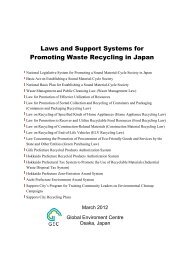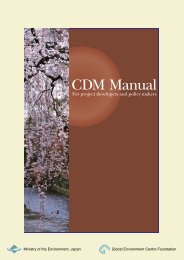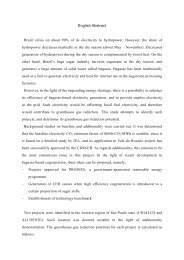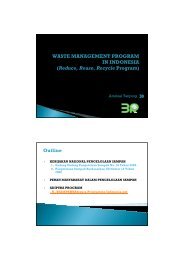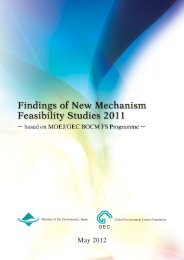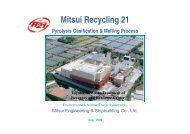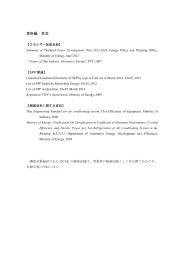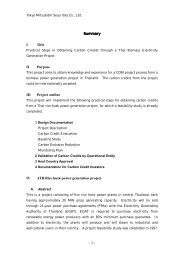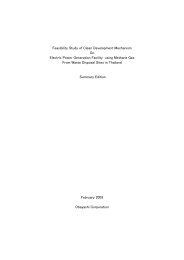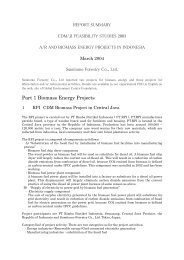PDF File - GEC
PDF File - GEC
PDF File - GEC
Create successful ePaper yourself
Turn your PDF publications into a flip-book with our unique Google optimized e-Paper software.
Section A.8. Approach for addressing non-permanence<br />
In accordance with paragraph 38 and section K of the A/R CDM M&P, project participants need to<br />
select one of the following approaches to address non-permanence:<br />
(a) Issuance of tCERs<br />
(b) Issuance of lCERs<br />
The approach chosen to address non-permanence shall remain fixed for the crediting period<br />
including any renewals.<br />
Non-permanence issue is explained in detail below.<br />
The issue of non-permanence arises from nature of GHG removals in forest. Unlike emission<br />
reductions, GHGs removed by forest may be released back into the atmosphere in an occasion of<br />
forest fires, die back from pests or even harvesting.<br />
The issue of non-permanence should be addressed through two different crediting systems named<br />
tCER and lCER. The differences between the two are illustrated with a hypothetical project case shown<br />
in Figure 3-1. Each graph has the same changes in net anthropogenic GHG removals while issuance<br />
of the credits is different reflecting the differences between tCERs and lCERs. The assumptions made<br />
here are:<br />
(a) Commitment periods would be of 5-year interval after the first commitment period,<br />
(b) Credits would be used (and retired) for achieving the target of a Party, and<br />
(c) Replacement of the credits expired would be done by the concerned Party (this situation<br />
would vary among countries and the project participants themselves may be held responsible<br />
for replacement).<br />
Each lCER shall expire at the end of the crediting period or, where a renewable crediting period is<br />
chosen, at the end of the last crediting period of the project activity. Each tCER shall expire at the end<br />
of the commitment period subsequent to the commitment period for which it was issued.<br />
Section A.9. Estimated amount of net anthropogenic GHG removals by sinks over the chosen<br />
crediting period:<br />
Project participants need to provide estimation of GHG removals as well as annual estimates for the<br />
chosen crediting period in the table below:<br />
Years<br />
Year A<br />
Year B<br />
Year C<br />
Year …<br />
Total (tCO 2 e)<br />
Summary of results obtained in Sections C.5., D.1. and D.2.<br />
Estimation of baseline<br />
GHG removals (tCO 2 e)<br />
Estimation of actual<br />
net GHG removals<br />
(tCO 2 e)<br />
Estimation of leakage<br />
(tCO 2 e)<br />
Estimation of net GHG<br />
removals (tCO 2 e)<br />
Figure 3-2 depicts the calculation of net anthropogenic GHG removals by sinks.<br />
The EB gave the following clarification on equations for the calculation of GHG emissions [EB22,<br />
Annex 15].<br />
55




